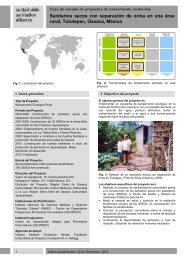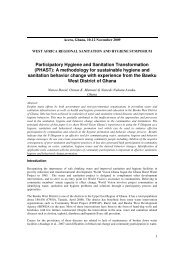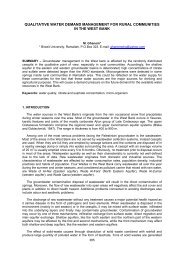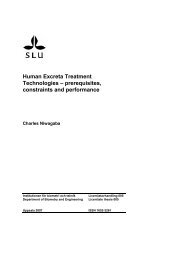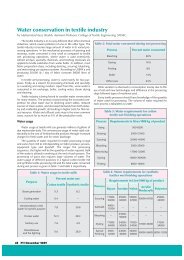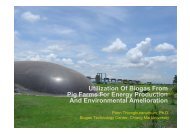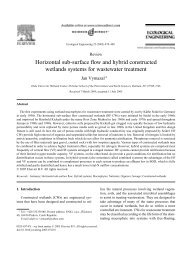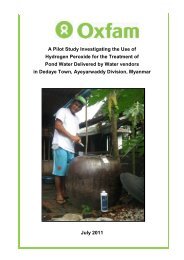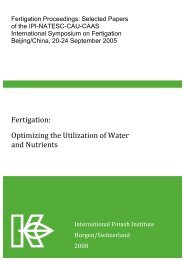Compilation of 13 factsheets on key sustainable sanitation ... - SSWM
Compilation of 13 factsheets on key sustainable sanitation ... - SSWM
Compilation of 13 factsheets on key sustainable sanitation ... - SSWM
You also want an ePaper? Increase the reach of your titles
YUMPU automatically turns print PDFs into web optimized ePapers that Google loves.
Decentralised safe reuse <str<strong>on</strong>g>of</str<strong>on</strong>g> wastewater and composted<br />
organic waste in UPA will help to:<br />
• Adapt to drought by facilitating year-round producti<strong>on</strong>,<br />
making safe use <str<strong>on</strong>g>of</str<strong>on</strong>g> wastewater and nutrients in water<br />
and organic waste;<br />
• Reduce the competiti<strong>on</strong> for fresh water between<br />
agriculture, domestic and industrial uses;<br />
• Reduce the discharge <str<strong>on</strong>g>of</str<strong>on</strong>g> wastewater into rivers, canals<br />
and other surface water and thus diminish their<br />
polluti<strong>on</strong>;<br />
• Make productive use <str<strong>on</strong>g>of</str<strong>on</strong>g> the nutrients in wastewater and<br />
organic wastes.<br />
UPA c<strong>on</strong>tributes to local ec<strong>on</strong>omic development, poverty<br />
alleviati<strong>on</strong>, social inclusi<strong>on</strong> <str<strong>on</strong>g>of</str<strong>on</strong>g> the urban poor – women in<br />
particular – and to reduced vulnerability <str<strong>on</strong>g>of</str<strong>on</strong>g> cities and their<br />
inhabitants. Nutrient loops can be closed and the<br />
envir<strong>on</strong>mental benefits <str<strong>on</strong>g>of</str<strong>on</strong>g> urban agriculture can be<br />
enhanced.<br />
7 Resource recovery in rural areas<br />
Almost 50% <str<strong>on</strong>g>of</str<strong>on</strong>g> the world populati<strong>on</strong> still live in rural areas,<br />
where local reuse can be relatively simple and make a big<br />
difference, especially for smallholder farmers. The resource<br />
potential <str<strong>on</strong>g>of</str<strong>on</strong>g> human excreta needs to be emphasised, and a<br />
close collaborati<strong>on</strong> with the agriculture sector established.<br />
Two recent productive sanitati<strong>on</strong> projects in Burkina Faso<br />
and Niger were financed from the agricultural sector (EU<br />
food facility and IFAD), where treated urine and faeces<br />
have been termed “liquid and solid fertiliser”, and toilets and<br />
urinals are promoted as “fertiliser factories” (see Dagerskog<br />
and B<strong>on</strong>zi, 2010). Agricultural extensi<strong>on</strong> workers were at<br />
the forefr<strong>on</strong>t <str<strong>on</strong>g>of</str<strong>on</strong>g> these projects, using farmer field schools to<br />
show the effect <str<strong>on</strong>g>of</str<strong>on</strong>g> treated urine and faeces as fertilisers.<br />
Figure 4: Increased vegetable crop yields when using urine as<br />
fertiliser in “Productive Sanitati<strong>on</strong> in Aguié Project” (source: L.<br />
Dagerskog, 2010). More photos: www.flickr.com/photos/gtzecosan<br />
/sets/72157627175906041.<br />
This created demand for toilets and urinals that transformed<br />
dangerous raw excreta into safe fertilisers. There are<br />
examples <str<strong>on</strong>g>of</str<strong>on</strong>g> villagers selling and buying treated urine and<br />
faeces, as well as households in surrounding villages that<br />
c<strong>on</strong>struct toilets or urinals <strong>on</strong> their own initiative to obtain<br />
the safe fertiliser.<br />
8 Instituti<strong>on</strong>al and legal aspects<br />
Weak, n<strong>on</strong>-existing or sometimes prohibiting legislati<strong>on</strong> <strong>on</strong><br />
reuse <str<strong>on</strong>g>of</str<strong>on</strong>g> excreta and wastewater makes it difficult to<br />
implement and scale up productive sanitati<strong>on</strong> systems.<br />
Ideally, a regulatory framework should facilitate the safe<br />
reuse <str<strong>on</strong>g>of</str<strong>on</strong>g> resources from sanitati<strong>on</strong> systems. Resource reuse<br />
may require changes to existing sanitati<strong>on</strong>, envir<strong>on</strong>mental<br />
and agricultural policies, or the development <str<strong>on</strong>g>of</str<strong>on</strong>g> new policies.<br />
Effective laws and regulati<strong>on</strong>s establish both incentives for<br />
complying as well as sancti<strong>on</strong>s for not complying with the<br />
requirements.<br />
The “Guidelines for safe use <str<strong>on</strong>g>of</str<strong>on</strong>g> wastewater, excreta and<br />
greywater in agriculture and aquaculture” (WHO, 2006) can<br />
be used as a reference when nati<strong>on</strong>al policies and<br />
legislati<strong>on</strong> are developed. These guidelines aim to protect<br />
the health <str<strong>on</strong>g>of</str<strong>on</strong>g> individuals and communities by recommending<br />
safe practice requirements and supporting the development<br />
<str<strong>on</strong>g>of</str<strong>on</strong>g> risk management.<br />
It is necessary to develop relevant legislati<strong>on</strong> al<strong>on</strong>g the<br />
sanitati<strong>on</strong> chain, from excreta treatment and transport to<br />
applicati<strong>on</strong> <str<strong>on</strong>g>of</str<strong>on</strong>g> fertiliser, restricti<strong>on</strong>s <strong>on</strong> the type <str<strong>on</strong>g>of</str<strong>on</strong>g> crops<br />
grown, occupati<strong>on</strong>al health, food hygiene and other<br />
preventive measures.<br />
A legal framework that focuses <strong>on</strong> desired functi<strong>on</strong>s <str<strong>on</strong>g>of</str<strong>on</strong>g> the<br />
sanitati<strong>on</strong> system rather than specific technologies<br />
stimulates innovati<strong>on</strong> and is not out-dated as fast as<br />
technology prescriptive regulatory frameworks. This is<br />
described by Kvarnström et al. (2011) using Sweden as an<br />
example where in 2006 nati<strong>on</strong>al guidelines for <strong>on</strong>-site<br />
sanitati<strong>on</strong> were developed.<br />
The Swedish guidelines are not focussing <strong>on</strong> technology per<br />
se but <strong>on</strong> the functi<strong>on</strong> <str<strong>on</strong>g>of</str<strong>on</strong>g> the sanitati<strong>on</strong> technology instead.<br />
They guide local authorities <strong>on</strong> what kind <str<strong>on</strong>g>of</str<strong>on</strong>g> expected results<br />
from the sanitati<strong>on</strong> system they should impose <strong>on</strong> the house<br />
owner. The nati<strong>on</strong>al guidelines especially emphasise the<br />
need to reduce the phosphorus loads to the recipient water<br />
bodies and the importance <str<strong>on</strong>g>of</str<strong>on</strong>g> nutrient recycling.<br />
In a setting with large-scale recycling <str<strong>on</strong>g>of</str<strong>on</strong>g> excreta (or<br />
“sanitati<strong>on</strong> products”), it is important to guarantee the quality<br />
from both a hygienic and an agricultural point <str<strong>on</strong>g>of</str<strong>on</strong>g> view to<br />
maintain trust between stakeholders. This could be achieved<br />
with a system <str<strong>on</strong>g>of</str<strong>on</strong>g> certificati<strong>on</strong>, including permits for<br />
pr<str<strong>on</strong>g>of</str<strong>on</strong>g>essi<strong>on</strong>als who work in the sanitati<strong>on</strong> chain, as well as<br />
quality c<strong>on</strong>trol <str<strong>on</strong>g>of</str<strong>on</strong>g> the sanitati<strong>on</strong> products. It is important not<br />
to over-burden the c<strong>on</strong>trol system as the regulati<strong>on</strong>s should<br />
be feasible to implement under local circumstances.<br />
Allowing treated excreta as fertilisers and organic matter<br />
sources in organic and c<strong>on</strong>venti<strong>on</strong>al agriculture would<br />
certainly boost recycling. The Internati<strong>on</strong>al Federati<strong>on</strong> <str<strong>on</strong>g>of</str<strong>on</strong>g><br />
Organic Agriculture Movements (IFOAM) restricts the use <str<strong>on</strong>g>of</str<strong>on</strong>g><br />
human excreta <strong>on</strong> food crops, but excepti<strong>on</strong>s may be made<br />
where detailed sanitati<strong>on</strong> requirements are established by<br />
the standard setting organisati<strong>on</strong> to prevent the transmissi<strong>on</strong><br />
<str<strong>on</strong>g>of</str<strong>on</strong>g> pathogens (IFOAM, 2005). However, if the use <str<strong>on</strong>g>of</str<strong>on</strong>g><br />
sanitised excreta in agriculture is prohibited in the food<br />
importing country, the exporting country will not use it except<br />
for own c<strong>on</strong>sumpti<strong>on</strong>. An example is the EU legislati<strong>on</strong> <strong>on</strong><br />
Productive sanitati<strong>on</strong> and the link to food security: Working Group 5 - page 5



